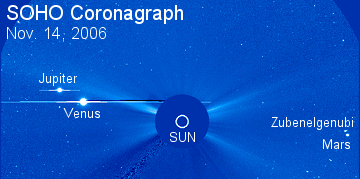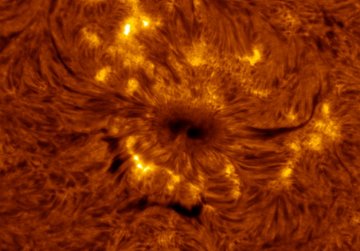 Autumn is here, and it's a wonderful time for stargazing. Find out what's up from Spaceweather PHONE.
Autumn is here, and it's a wonderful time for stargazing. Find out what's up from Spaceweather PHONE.
RETURN OF THE LEONIDS: Earth is heading for a cloud of comet dust that could produce an outburst of Leonid meteors on Nov. 19th. Get the full story from Science@NASA.
AROUND THE SUN: If this happened at midnight, it would be big news for sky watchers. Instead it's happening at noon when no one can see it.
"It" is a stunning close encounter between the two brightest planets: Venus and Jupiter are less than 0.5o apart today. The get-together is happening just left of the Sun:

While humans cannot see the event, SOHO can. The spacecraft's coronagraph blocks the sun's glare, revealing not only Venus and Jupiter but also Mars and Zubenelgenubi having their own close encounter. There's a lot going on around the sun: Join SOHO for a ringside seat.
DAY OWL: "I thought owls only come out at night," says photographer Gary Palmer of Los Angeles, "but sunspot 923 proved otherwise. It looks just like an owl in flight." (continued below)

Sunspot 923, the view through a SolarMax70. Credit: Gary Palmer.
The eyes of this bird are two halves of the sunspot, which is suddenly breaking apart. The split may signal an increase in activity from sunspot 923, which is overdue for a big flare. Stay tuned.
more images: from Wayne Wooten of Pensacola, Florida; from Adrian Guzman of San Jose, California.
BONUS: Transit of Mercury Photo Gallery

